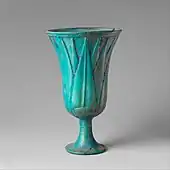| Lotiform Vessels | |
|---|---|
 The Lotiform Chalice, Metropolitan Museum of Art | |
| Year | c. B.C 1069 – 664 |
| Medium | Quartz and calcite lime based glaze on earthenware |
| Location | Metropolitan Museum of Art |
The Metropolitan Museum of Art has a number of blue faience vases and chalices from Ancient Egypt in its collection. The vessels, which range in condition from full works to fragments, are dated to the Third Intermediate Period of Egypt.[1][2][3]
Description
Egyptian faience pottery (as opposed to modern faience) was made from fired earthenware colored with a glaze. The art style was popular in the Third Intermediate Period (c. 1069 BC – c. 664 BC) of Egyptian history. Blue-green, the most popular color used on the earthenware, was achieved through the use of a quartz and calcite lime-based glaze.[4] Egyptian potters crafted relief vases, chalices, and bowls. Many items depicted reeds, lotuses, rivers, aquatic animals, and people, likely due to the glaze's blue-green coloration being associated with water.[1][2][5]
Lotiform Chalice
The Lotiform Chalice (c. 945–664 B.C.) is faience relief chalice. Images carved into the chalice depict fish, papyrus clumps, and lotus blooms. The vessel's images possibly portray legends surrounding the flooding of the Nile, an event that was of significant economic and spiritual importance to the ancient Egyptians.[1][5]
Reconstructed lotiform chalice

Pieced together with pottery fragments, a second lotiform chalice in the Metropolitan Museum of Art's collection depicts a scene in which the god Hapi presents a ruler of Egypt with palm ribs and a scepter. The gifts (which take the shape of ankhs) are intended to bestow good fortune and long life upon the recipient.[6]
Fragments
The Metropolitan Museum of Art also maintains several fragments of Egyptian faience pottery dated between 945 and 712 B.C.[2][3]
Gallery
- Various lotiform vessels in the collection of the Metropolitan Museum of Art
 Chalice fragment, circa 1070–664 B.C.
Chalice fragment, circa 1070–664 B.C. Cup, circa 1295–1185 B.C.
Cup, circa 1295–1185 B.C. Cup, circa 1479–1425 B.C.
Cup, circa 1479–1425 B.C. Relief chalice fragment, circa 1070–712 B.C.
Relief chalice fragment, circa 1070–712 B.C. Relief chalice with inscription, circa 945–712 BC
Relief chalice with inscription, circa 945–712 BC
References
- 1 2 3 "Lotiform Chalice | Third Intermediate Period | The Met". The Metropolitan Museum of Art, i.e. The Met Museum. Retrieved 2018-05-14.
- 1 2 3 "Rim fragment of relief chalice with inscription and papyrus plants, associated with 1983.599 | Third Intermediate Period | The Met". The Metropolitan Museum of Art, i.e. The Met Museum. Retrieved 2018-05-14.
- 1 2 "Chalice fragment showing a file of nude females in a marshy landscape, inscribed, associated with 2013.635 | Third Intermediate Period | The Met". The Metropolitan Museum of Art, i.e. The Met Museum. Retrieved 2018-05-14.
- ↑ Nicholson and Peltenburg 2000. Ancient Egyptian Materials and Technology. In: Nicholson, P.T. and Shaw, I.Cambridge: Cambridge University Press, 177-194.137–142.
- 1 2 Friedman, F.D. (ed.). 1998. Gifts of the Nile-ancient Egyptian faience. London: Thames and Hudson. 177-194.137–142.
- ↑ "Reconstructed lotiform chalice | Third Intermediate Period or later | The Met". The Metropolitan Museum of Art, i.e. The Met Museum. Retrieved 2018-05-14.